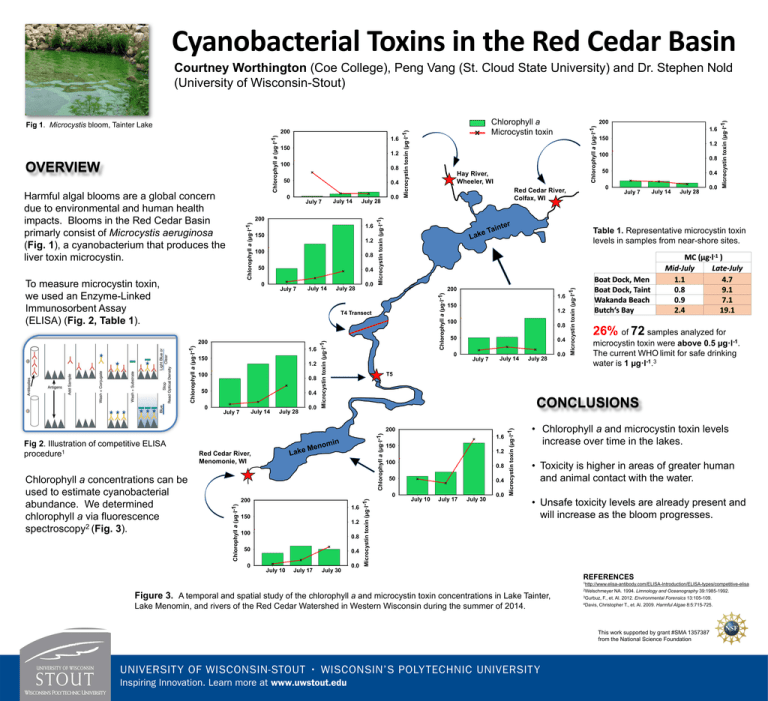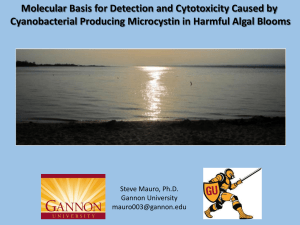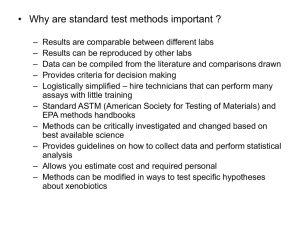Cyanobacterial Toxins in the Red Cedar Basin Courtney Worthington 72 (University of Wisconsin-Stout)
advertisement

Cyanobacterial Toxins in the Red Cedar Basin Chlorophyll a Microcystin toxin 100 0.8 50 0.4 July 14 July 7 July 28 Chlorophyll a (µg·l-1) 200 To measure microcystin toxin, we used an Enzyme-Linked Immunosorbent Assay (ELISA) (Fig. 2, Table 1). 1.6 150 1.2 100 0.8 50 0.4 0 July 7 July 14 July 28 0.0 0.0 Hay River, Wheeler, WI Red Cedar River, Colfax, WI 200 Chlorophyll a (µg·l-1) 1.6 150 1.2 100 0.8 50 0.4 0 0.0 July 14 July 7 July 28 Microcystin toxin (µg·l-1) T4 Transect 200 1.6 150 1.2 100 0.8 50 0.4 0 0.0 July 7 July 14 Chlorophyll a (µg·l-1) 1.6 150 1.2 0.8 50 0.4 0 0.0 July 10 July 17 July 30 Microcystin toxin (µg·l-1) 200 100 1.2 100 0.8 50 0.4 0 0.0 July 7 July 14 July 28 July 28 Boat Dock, Men Boat Dock, Taint Wakanda Beach Butch‘s Bay MC (µg·l-1 ) Mid-July Late-July 1.1 4.7 0.8 9.1 0.9 7.1 2.4 19.1 26% of 72 samples analyzed for microcystin toxin were above 0.5 µg·l-1. The current WHO limit for safe drinking water is 1 µg·l-1.3 CONCLUSIONS Red Cedar River, Menomonie, WI Chlorophyll a (µg·l-1) Chlorophyll a concentrations can be used to estimate cyanobacterial abundance. We determined chlorophyll a via fluorescence spectroscopy2 (Fig. 3). 150 T5 200 Fig 2. Illustration of competitive ELISA procedure1 1.6 Table 1. Representative microcystin toxin levels in samples from near-shore sites. Microcystin toxin (µg·l-1) 0 Chlorophyll a (µg·l-1) 1.2 1.6 150 1.2 100 0.8 50 0.4 0 0.0 July 10 July 17 July 30 Microcystin toxin (µg·l-1) Harmful algal blooms are a global concern due to environmental and human health impacts. Blooms in the Red Cedar Basin primarly consist of Microcystis aeruginosa (Fig. 1), a cyanobacterium that produces the liver toxin microcystin. 150 Chlorophyll a (µg·l-1) OVERVIEW 1.6 Microcystin toxin (µg·l-1) Chlorophyll a (µg·l-1) 200 Microcystin toxin (µg·l-1) Fig 1. Microcystis bloom, Tainter Lake 200 Microcystin toxin (µg·l-1) Courtney Worthington (Coe College), Peng Vang (St. Cloud State University) and Dr. Stephen Nold (University of Wisconsin-Stout) • Chlorophyll a and microcystin toxin levels increase over time in the lakes. • Toxicity is higher in areas of greater human and animal contact with the water. • Unsafe toxicity levels are already present and will increase as the bloom progresses. REFERENCES 1http://www.elisa-antibody.com/ELISA-Introduction/ELISA-types/competitive-elisa Figure 3. A temporal and spatial study of the chlorophyll a and microcystin toxin concentrations in Lake Tainter, Lake Menomin, and rivers of the Red Cedar Watershed in Western Wisconsin during the summer of 2014. 2Welschmeyer NA. 1994. Limnology and Oceanography 39:1985-1992. 3Gurbuz, F., et. Al. 2012. Environmental Forensics 13:105-109. 4Davis, Christopher T., et. Al. 2009. Harmful Algae 8:5:715-725. This work supported by grant #SMA 1357387 from the National Science Foundation







